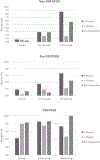Postbariatric hypoglycemia: symptom patterns and associated risk factors in the Longitudinal Assessment of Bariatric Surgery study
- PMID: 34294589
- PMCID: PMC9944569
- DOI: 10.1016/j.soard.2021.04.021
Postbariatric hypoglycemia: symptom patterns and associated risk factors in the Longitudinal Assessment of Bariatric Surgery study
Abstract
Background: Postbariatric hypoglycemia (PBH) can be a devastating complication for which current therapies are often incompletely effective. More information is needed regarding frequency, incidence, and risk factors for PBH.
Objectives: To examine hypoglycemia symptoms following Roux-en-Y gastric bypass (RYGB) and laparoscopic adjustable gastric banding (LAGB) and baseline and in-study risk factors.
Setting: Multicenter, at 10 US hospitals in 6 geographically diverse clinical centers.
Methods: A prospective, longitudinal cohort study of adults undergoing RYGB or LAGB as part of clinical care between 2006 and 2009 were recruited and followed until January 31, 2015, with baseline and annual postoperative research assessments. We analyzed baseline prevalence and post-operative incidence and frequency of self-reported hypoglycemia symptoms as well as potential preoperative risk factors.
Results: In all groups, postoperative prevalence of hypoglycemia symptoms was 38.5%. Symptom prevalence increased postoperatively from 2.8%-36.4% after RYGB in patients without preoperative diabetes (T2D), with similar patterns in prediabetes (4.9%-29.1%). Individuals with T2D had higher baseline hypoglycemia symptoms (28.9%), increasing after RYGB (57.9%). Hypoglycemia symptoms were lower after LAGB, with 39.1% reported hypoglycemia symptoms at only 1 postoperative visit with few (4.0%) having persistent symptoms at 6 or more annual visits. Timing of symptoms was not restricted to the postprandial state. Symptoms of severe hypoglycemia were reported in 2.6-3.6% after RYGB. The dominant risk factor for postoperative symptoms was preoperative symptoms; additionally, baseline selective serotonin (SSRI) and serotonin-norepinephrine (SNRI) reuptake inhibitor use was also associated with increased risk in multivariable analysis. Weight loss and regain were not related to hypoglycemia symptom reporting.
Conclusion: Hypoglycemia symptoms increase over time after RYGB, particularly in patients without diabetes. In a small percentage, symptoms can be persistent or severe and require hospitalization. Preoperative hypoglycemia symptoms and SSRI/SNRI use in RYGB patients without diabetes is associated with increased risk of symptoms.
Keywords: Bariatric surgery; Diabetes; Hypoglycemia; Laparoscopic adjustable gastric band; Roux-en-Y gastric bypass; SNRI; SSRI.
Copyright © 2021. Published by Elsevier Inc.
Figures





References
-
- Lee CJ, Brown TT, Schweitzer M, Magnuson T, Clark JM. The incidence and risk factors associated with developing symptoms of hypoglycemia after bariatric surgery. Surg Obes Relat Dis 2018;14(6):797–802. - PubMed
-
- Relligoli A, Sanna M, Serra R, et al. incidence and predictors of hypoglycemia 1 year after laparoscopic sleeve gastrectomy. Obes Surg 2017;27(12):3179–86. - PubMed
Publication types
MeSH terms
Grants and funding
- R01 DK103842/DK/NIDDK NIH HHS/United States
- U01 DK066555/DK/NIDDK NIH HHS/United States
- UL1 RR024153/RR/NCRR NIH HHS/United States
- R01 DK106193/DK/NIDDK NIH HHS/United States
- UL1 RR024996/RR/NCRR NIH HHS/United States
- U01 DK066526/DK/NIDDK NIH HHS/United States
- M01 RR000037/RR/NCRR NIH HHS/United States
- P30 DK036836/DK/NIDDK NIH HHS/United States
- R01 DK121995/DK/NIDDK NIH HHS/United States
- U01 DK066667/DK/NIDDK NIH HHS/United States
- U01 DK066471/DK/NIDDK NIH HHS/United States
- U01 DK114156/DK/NIDDK NIH HHS/United States
- U01 DK066585/DK/NIDDK NIH HHS/United States
- U01 DK066557/DK/NIDDK NIH HHS/United States
- U01 DK066568/DK/NIDDK NIH HHS/United States
LinkOut - more resources
Full Text Sources
Medical
Research Materials

